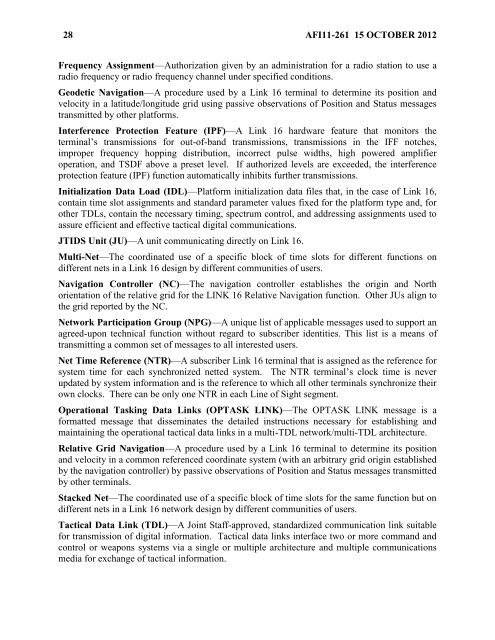By order of the air force instruction 11-261 - Air Force E-Publishing ...
By order of the air force instruction 11-261 - Air Force E-Publishing ...
By order of the air force instruction 11-261 - Air Force E-Publishing ...
You also want an ePaper? Increase the reach of your titles
YUMPU automatically turns print PDFs into web optimized ePapers that Google loves.
28 AFI<strong>11</strong>-<strong>261</strong> 15 OCTOBER 2012<br />
Frequency Assignment—Authorization given by an administration for a radio station to use a<br />
radio frequency or radio frequency channel under specified conditions.<br />
Geodetic Navigation—A procedure used by a Link 16 terminal to determine its position and<br />
velocity in a latitude/longitude grid using passive observations <strong>of</strong> Position and Status messages<br />
transmitted by o<strong>the</strong>r platforms.<br />
Interference Protection Feature (IPF)—A Link 16 hardware feature that monitors <strong>the</strong><br />
terminal’s transmissions for out-<strong>of</strong>-band transmissions, transmissions in <strong>the</strong> IFF notches,<br />
improper frequency hopping distribution, incorrect pulse widths, high powered amplifier<br />
operation, and TSDF above a preset level. If authorized levels are exceeded, <strong>the</strong> interference<br />
protection feature (IPF) function automatically inhibits fur<strong>the</strong>r transmissions.<br />
Initialization Data Load (IDL)—Platform initialization data files that, in <strong>the</strong> case <strong>of</strong> Link 16,<br />
contain time slot assignments and standard parameter values fixed for <strong>the</strong> platform type and, for<br />
o<strong>the</strong>r TDLs, contain <strong>the</strong> necessary timing, spectrum control, and addressing assignments used to<br />
assure efficient and effective tactical digital communications.<br />
JTIDS Unit (JU)—A unit communicating directly on Link 16.<br />
Multi-Net—The coordinated use <strong>of</strong> a specific block <strong>of</strong> time slots for different functions on<br />
different nets in a Link 16 design by different communities <strong>of</strong> users.<br />
Navigation Controller (NC)—The navigation controller establishes <strong>the</strong> origin and North<br />
orientation <strong>of</strong> <strong>the</strong> relative grid for <strong>the</strong> LINK 16 Relative Navigation function. O<strong>the</strong>r JUs align to<br />
<strong>the</strong> grid reported by <strong>the</strong> NC.<br />
Network Participation Group (NPG)—A unique list <strong>of</strong> applicable messages used to support an<br />
agreed-upon technical function without regard to subscriber identities. This list is a means <strong>of</strong><br />
transmitting a common set <strong>of</strong> messages to all interested users.<br />
Net Time Reference (NTR)—A subscriber Link 16 terminal that is assigned as <strong>the</strong> reference for<br />
system time for each synchronized netted system. The NTR terminal’s clock time is never<br />
updated by system information and is <strong>the</strong> reference to which all o<strong>the</strong>r terminals synchronize <strong>the</strong>ir<br />
own clocks. There can be only one NTR in each Line <strong>of</strong> Sight segment.<br />
Operational Tasking Data Links (OPTASK LINK)—The OPTASK LINK message is a<br />
formatted message that disseminates <strong>the</strong> detailed <strong>instruction</strong>s necessary for establishing and<br />
maintaining <strong>the</strong> operational tactical data links in a multi-TDL network/multi-TDL architecture.<br />
Relative Grid Navigation—A procedure used by a Link 16 terminal to determine its position<br />
and velocity in a common referenced coordinate system (with an arbitrary grid origin established<br />
by <strong>the</strong> navigation controller) by passive observations <strong>of</strong> Position and Status messages transmitted<br />
by o<strong>the</strong>r terminals.<br />
Stacked Net—The coordinated use <strong>of</strong> a specific block <strong>of</strong> time slots for <strong>the</strong> same function but on<br />
different nets in a Link 16 network design by different communities <strong>of</strong> users.<br />
Tactical Data Link (TDL)—A Joint Staff-approved, standardized communication link suitable<br />
for transmission <strong>of</strong> digital information. Tactical data links interface two or more command and<br />
control or weapons systems via a single or multiple architecture and multiple communications<br />
media for exchange <strong>of</strong> tactical information.
















